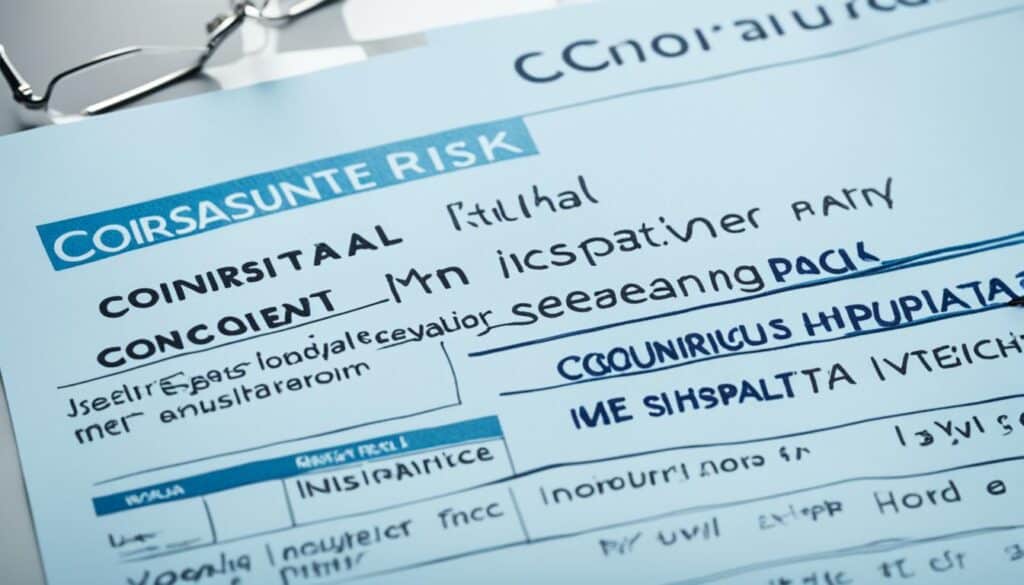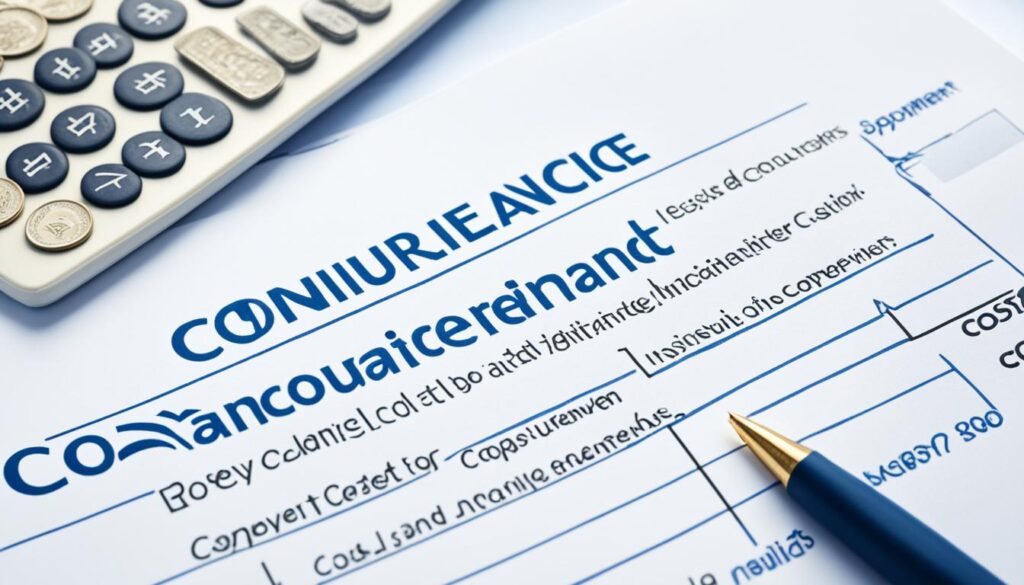Coinsurance is a way to share healthcare costs between you and your insurance company. You pay a part of the bill, and they pay the rest. Knowing the good and bad sides of coinsurance helps you choose the right medical plan. This article will look at the benefits and drawbacks of coinsurance to help you understand its effect on your healthcare costs.
Key Takeaways
- Coinsurance requires the insured to pay a fixed percentage of the total cost of a covered healthcare service.
- The insurer covers the remaining percentage, typically 80% or more, of the total cost.
- Coinsurance can help lower monthly premiums but may result in higher out-of-pocket expenses for the insured.
- Coinsurance provides an incentive for the insured to be more informed and responsible consumers of healthcare services.
- Coinsurance may not be suitable for individuals with chronic or ongoing medical conditions that require frequent care.
What Is Coinsurance
Coinsurance is the part of a claim cost that an insured person must pay after the deductible is met. It’s a common part of health insurance plans. It can also be found in property insurance policies.
Key Takeaways
- Coinsurance is the percentage under an insurance plan that the insured person pays towards a covered expense or service.
- Coinsurance kicks in after the policy deductible is satisfied.
- One of the most common coinsurance breakdowns is the 80/20 split: The insurer pays 80%, the insured 20%.
How Coinsurance Works
Coinsurance is like a copayment but different. Copays are a set dollar amount paid at service time. Coinsurance is a percentage of the cost. A common coinsurance is the 80/20 split, where you pay 20% and the insurer pays 80%. This happens after you’ve paid the deductible.
Plans with lower monthly premiums often have higher coinsurance. Plans with higher premiums have lower coinsurance.
Example of Coinsurance
Let’s say you have a health insurance policy with an 80/20 coinsurance, a $1,000 deductible, and a $5,000 out-of-pocket max. You need outpatient surgery that costs $5,500 early in the year. First, you pay the $1,000 deductible.
After that, you pay 20% of the $4,500 left, which is $900. Your insurance covers the other 80%, or $4,600. If you need another expensive procedure later, you won’t wait to start paying coinsurance since you’ve already met your deductible.
Copay vs. Coinsurance
When looking at healthcare costs, copay and coinsurance are often confusing terms. They are both ways insurance companies share costs with policyholders. But they work in different ways.
Pros and Cons of Coinsurance
Coinsurance makes policyholders pay a percentage of their medical bills, often 20% or more, after the deductible. This can lead to lower monthly premiums. But, it means paying more upfront and possibly higher out-of-pocket costs for expensive treatments.
Pros and Cons of Copays
- Copay plans charge a fixed amount, like $20 or $30, for each visit or service.
- The main benefit of copays is they make healthcare costs predictable and easier to budget for.
- The main drawback is higher monthly premiums and paying the copay for each visit, even after the deductible.
Choosing between copay vs. coinsurance depends on your healthcare needs, budget, and how much risk you can handle. If you go to the doctor often, copays might be better because they’re predictable. If you don’t go to the doctor much, a coinsurance plan with lower premiums might be better.
Property Insurance Coinsurance
In property insurance, the coinsurance clause is key. It usually asks that a home or property be insured for about 80% of its total value. If it’s not, and a claim is filed, the owner might face a coinsurance penalty.
Waiver of Coinsurance
Homeowners can avoid this penalty with a waiver of coinsurance. This lets them skip the coinsurance requirement. But, insurance companies are more likely to agree to this for small claims, not big ones.
It’s important for property owners to understand property insurance coinsurance and the waiver of coinsurance. This knowledge helps them make smart choices and be well-protected if they need to file a claim. By looking over their policy and exploring options, homeowners can strike the right balance between risk and protection.
“The coinsurance clause is a critical factor in property insurance, but homeowners can mitigate its impact through the waiver of coinsurance.”
Understanding Coinsurance

Coinsurance is a key idea in insurance, especially for health coverage. It means the insured person pays a part of their medical bills. The insurance company pays the rest. For example, if you have a “30% coinsurance” policy, you pay 30% of the bill, and the insurance covers 70%.
This system makes health insurance cheaper for everyone. But, it also means you need to think about your healthcare spending. You and your insurance company share the cost, which helps keep premiums down.
| Percentage of Coinsurance | Responsibility of the Insured | Responsibility of the Insurance Provider |
|---|---|---|
| 20% | 20% | 80% |
| 30% | 30% | 70% |
| 40% | 40% | 60% |
Knowing about coinsurance helps people make smart choices about their health insurance. It lets them plan their budgets better. By understanding their share of costs, people can manage their healthcare spending and get the care they need without spending too much.
“Coinsurance encourages individuals to be active participants in their healthcare decisions, promoting a more efficient and cost-effective healthcare system.”
Coinsurance Defined

Coinsurance is a key term in healthcare and insurance. It means the part of medical costs that you pay after your deductible. This includes things like hospital stays, doctor visits, and prescriptions.
How Does Coinsurance Work?
Coinsurance splits the cost between you and your insurance company. You usually pay a smaller part, like 20% or 30%. But this happens only after you’ve paid your deductible. After that, you pay a certain percentage, and your insurer covers the rest.
Let’s say your coinsurance is 80/20. This means your insurance pays 80% of your medical bills, and you pay the other 20%. This way, healthcare costs are easier to handle for you, but everyone still shares the cost.
| Deductible Met? | Insurer’s Share | Insured’s Share |
|---|---|---|
| Yes | 80% | 20% |
| No | 0% | 100% |
Knowing about coinsurance helps you make better choices about your health insurance and how much you’ll pay.
Coinsurance vs. Copayment

When looking at healthcare costs, you’ll often hear about coinsurance and copayment. These are both ways insurance plans share costs with you. But they work differently.
Coinsurance means you pay a percentage of the total cost after you’ve met your deductible. For instance, if the coinsurance is 20%, you pay 20% and the insurance covers 80%.
A copayment, however, is a set amount you pay when you get a service. It doesn’t matter the cost of the service. Copays are often for regular visits or medicines and don’t require meeting a deductible first.
| Coinsurance | Copayment |
|---|---|
| Percentage-based cost-sharing | Fixed dollar amount cost-sharing |
| Applies after deductible is met | Paid at time of service, regardless of deductible |
| Percentage is fixed | Amount can vary by service type |
The big difference between coinsurance and copay is how they share costs. Coinsurance is a percentage, while a copay is a set amount. This means coinsurance can change based on the service cost.
“Coinsurance and copays are both ways for insurance plans to share costs with policyholders, but they have distinct features that can impact an individual’s out-of-pocket expenses.”
When picking a healthcare plan, knowing the coinsurance vs. copay difference is key. It helps you choose what’s best for your budget and needs.
Pros and Cons of Coinsurance
Coinsurance is a common part of healthcare plans. It has both good and bad sides. Knowing the pros and cons of coinsurance helps people pick the best coverage for their needs.
One big plus of coinsurance is it can make premiums cheaper. By sharing costs with the insurance company, people might pay less each month. It also covers many medical needs after the deductible is paid, helping with routine healthcare costs.
But, coinsurance has downsides too. You must pay the deductible first before insurance helps, which can be hard for some. Also, it’s hard to know how much you’ll pay because the cost share varies by service or procedure. This can lead to big out-of-pocket costs, even with a small coinsurance percentage.
| Pros of Coinsurance | Cons of Coinsurance |
|---|---|
|
|
When picking a health insurance plan, it’s important to think about the advantages and disadvantages of coinsurance. This way, you can find a plan that fits your health needs and budget.
Choosing Between Coinsurance And Copays
When picking health insurance, you often face the choice between coinsurance and copays. Knowing the good and bad of each can help you pick what’s best for your health and wallet.
Copays are usually cheaper for doctor visits, as you pay a set amount (like $20 for a visit). This can be good if you go to the doctor often. Coinsurance, however, might be cheaper if you have many or expensive medical needs.
Coinsurance means you pay a part (like 20%) of the bill for each service. Your insurance covers the rest. This can lead to higher costs per visit but might be cheaper over time if you need a lot of care.
When deciding between coinsurance and copays, think about your expected medical costs. Consider premiums, deductibles, and how much you’ll pay for each service. This will help you pick the best option for your needs and budget.
“Choosing the right balance between coinsurance and copays can make a significant difference in your overall healthcare costs.”
The choice between coinsurance and copays depends on your health needs and money situation. By looking at the pros and cons, you can pick the coverage that gives you the most value and protection for your family.
Out-of-Pocket Maximums
The out-of-pocket maximum is key to understanding healthcare costs. It’s the highest amount you’ll pay for healthcare services in a year. After reaching this limit, your plan covers 100% of costs for the rest of the year.
Your copays and coinsurance add up to your out-of-pocket maximum. Once you hit this limit, your plan pays for all in-network services you get.
Knowing your plan’s out-of-pocket maximum helps with budgeting. It lets you plan for medical costs and avoid paying too much.
| Plan Feature | Explanation |
|---|---|
| Out-of-Pocket Maximum | The maximum amount you’ll pay for in-network healthcare services within a year. |
| Copays and Coinsurance | Both copays and coinsurance payments count towards meeting your out-of-pocket maximum. |
| Plan Coverage | Once you reach your out-of-pocket maximum, your health plan will cover 100% of the remaining in-network costs for the rest of the year. |
It’s important to stay under your out-of-pocket maximum to manage healthcare costs. Understanding this helps you make better choices about your healthcare plan. This way, you get the best value from your coverage.
Coinsurance
Coinsurance is a key idea in insurance, especially in health insurance. It means the insured person pays a set percentage of healthcare costs. This happens after they’ve met their deductible. Knowing about coinsurance and how it differs from copays is key when picking a health insurance plan. This plan should fit your medical needs and budget.
Coinsurance is the part of healthcare costs you pay, shown as a percentage. For instance, a plan with an 80/20 coinsurance means you pay 20% and the insurance covers 80%. This way, both you and the insurer have a reason to keep healthcare costs down.
Coinsurance and copays are different. Copays are a fixed amount you pay for a service, like $20 for a doctor’s visit. Coinsurance is a percentage of the total cost you pay.
| Coinsurance | Copayment |
|---|---|
| Percentage-based cost sharing | Fixed dollar amount |
| Typically applies after deductible is met | Applies before or after deductible is met |
| Insured pays a percentage of the total cost | Insured pays a fixed dollar amount per service |
It’s important to understand what is coinsurance and how it works when choosing health insurance. By comparing coinsurance and copays, you can pick a plan that fits your budget and healthcare needs.
Also Read : What Does Renters Insurance Protection Include?
Conclusion
Coinurance is a way that insurance plans share costs with the policyholder. After meeting the deductible, you pay a set percentage of healthcare costs. This can make premiums cheaper, but it also means you might pay more out-of-pocket, especially if you need a lot of medical care.
It’s important to think about the good and bad of coinsurance when picking an insurance plan. You should think about how much healthcare you’ll need, your budget, and how much risk you can handle. This helps you choose a plan that fits your health and money needs.
Coinurance is a tricky part of insurance that needs careful thought. By understanding how coinsurance works and comparing it to other ways of sharing costs, you can pick the best coverage for you. This way, you can make a choice that suits your health and money situation.
FAQs
Q: What is coinsurance in health insurance?
A: Coinsurance is the amount you are responsible for paying for covered health care services after you have met your deductible. It is typically expressed as a percentage of the costs.
Q: How does coinsurance work after reaching your deductible?
A: After you reach your deductible, your health plan will start to pay its share, and you will pay coinsurance costs, which is a percentage of the remaining medical expenses.
Q: What is the difference between a copay and coinsurance?
A: A copay is a flat fee you pay for a specific health care service, while coinsurance is a percentage of the costs you’re responsible for after your deductible has been met.
Q: How does Medicare coinsurance work?
A: With Medicare, coinsurance generally applies after you have met the annual deductible. For example, Medicare Part B typically requires you to pay 20% of the approved amount for covered services after the deductible is satisfied.
Q: What are out-of-network coinsurance costs?
A: Out-of-network coinsurance costs refer to the percentage of costs you are responsible for when you receive health care services from providers not contracted with your health insurance plan. These costs are usually higher than in-network coinsurance rates.
Q: Do all health plans have coinsurance?
A: Not all health plans have coinsurance. Some may only have copays or may not require any additional payment after the deductible is met. It’s important to review your specific health plan details.
Q: How can I minimize my coinsurance costs?
A: To minimize your coinsurance costs, you can choose an in-network provider, understand your health plan’s coinsurance rates, and anticipate your health care needs to manage expenses effectively.
Q: What should I consider when selecting a health insurance plan with coinsurance?
A: When selecting a health insurance plan, consider the coinsurance rate, whether the plan covers your preferred providers, and how the deductible and coinsurance interact to affect your overall health care costs.
Q: What happens if I don’t reach my deductible?
A: If you don’t reach your deductible, you will be responsible for the full costs of your health care services, as your health insurance company will not cover any expenses until the deductible is met.
Source Links
- https://www.investopedia.com/terms/c/coinsurance.asp
- https://www.forbes.com/advisor/health-insurance/coinsurance-vs-copay/
- https://www.healthforcalifornia.com/blog/what-is-coinsurance